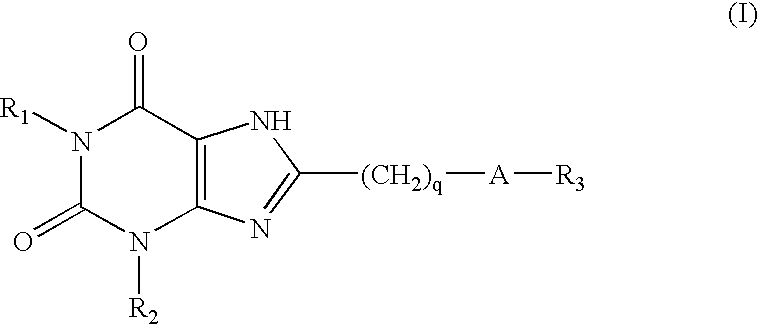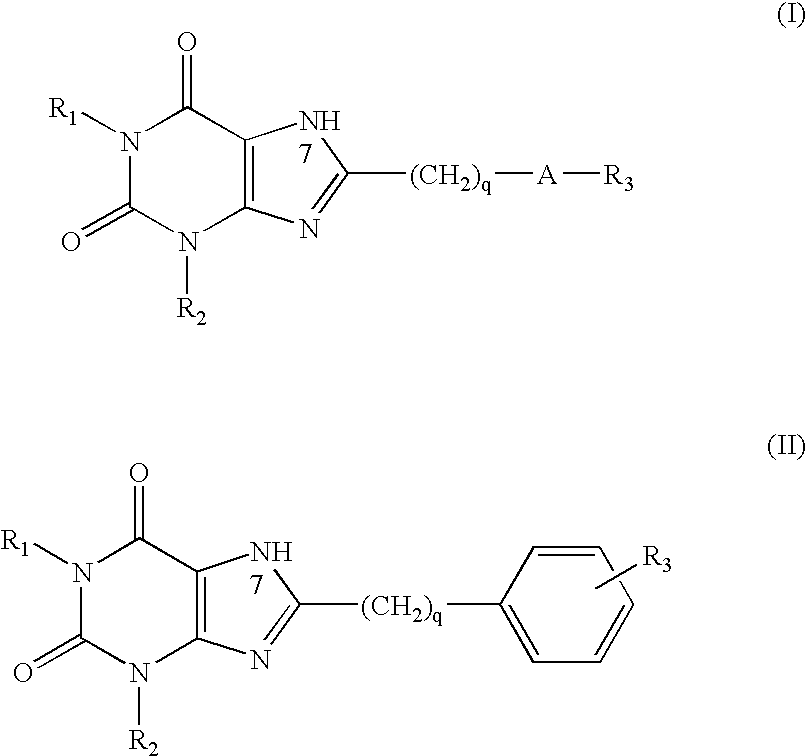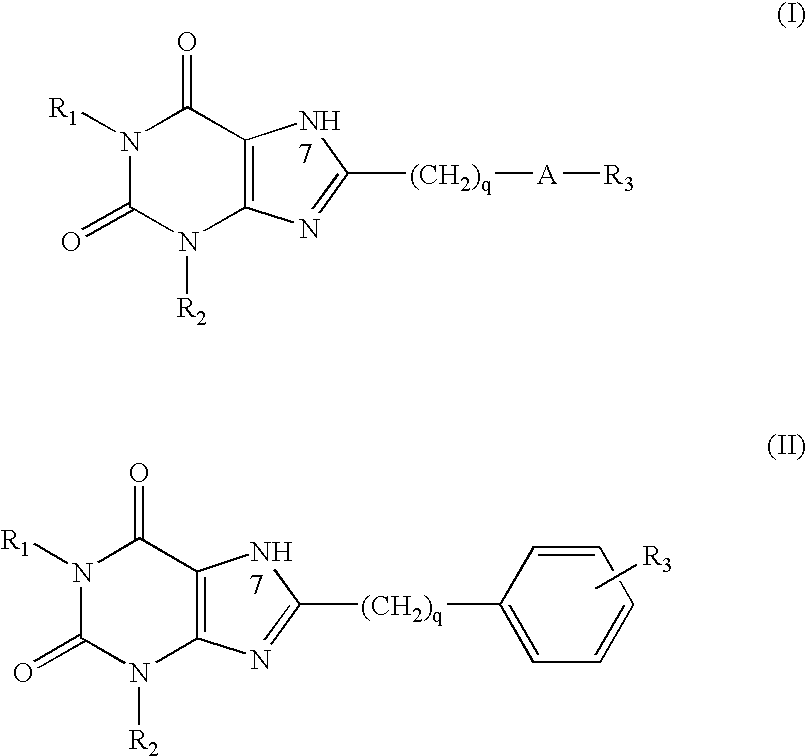A1 adenosine receptor antagonists
a technology of adenosine receptor and antagonist, which is applied in the field of compounds, can solve the problems of poor water solubility, low potency or lack of selectivity of adenosine receptor, and the development of adenosine receptors has not fully addressed the problems of potency and selectivity
- Summary
- Abstract
- Description
- Claims
- Application Information
AI Technical Summary
Benefits of technology
Problems solved by technology
Method used
Image
Examples
example 1
Synthesis of 5,6-Diamino-1-[2-(4-nitrophenyl)ethyl]-3-propyluracil (6)
[0189]
[0190]Step a: Conversion of 4-Nitrophenethylamine Hydrochloride (1) to 1-[2-(4-Nitrophenyl)ethyl]-1′-propylurea (2). To a slurry of 777 gm of 4-nitrophenethylamine hydrochloride (1) and 11.2 L of toluene was added slowly, 620 mL of triethylamine and this mixture was stirred for 30 min. at room temperature. To this suspension was then added slowly, 398 mL of n-propyl isocyanate, and the mixture was stirred overnight at room temperature to give a solid precipitate. The heterogeneous mixture was filtered and the isolated solids were washed with 1.5 L of toluene and then air dried. The 2.3 kg of crude product was stirred with 6 L of water to dissolve residual triethylamine hydrochloride. The solids were isolated by filtration and air dried. This material was dissolved in 4 L of absolute ethanol and 1 L of water was added to induce crystallization. The solids were filtered, washed with 2 L of 1:1 ethanol-water an...
example 2
Synthesis of 8-Benzyl-3-[2-(4-nitrophenyl)ethyl]-1-propylxanthine (9)
[0195]
[0196]A solution of 44.9 gm of phenylacetic acid in 630 mL of dimethylformamide (DMF) was chilled in an ice water bath and 63.38 gm of 1-(3-dimethylaminopropyl)-3-ethylcarbodiimide hydrochloride (EDC) was added followed by 5.24 gm of 4-dimethylaminopyridine (DMAP). This mixture was stirred at ca. 4 degrees C. for 30 minutes and 100 gm of 5,6-diamino-1-[2-(4-nitrophenyl)ethyl]-3-propyluracil (6) was added in one portion. This mixture was stirred for 60 hr at room temperature. The dark homogeneous solution was poured into 700 mL of ice water with stirring to effect precipitation. The solids were isolated by filtration, washed with three 100 mL portions of water and dried under vacuum to yield 103 gm of a mixture of 5-amino-1-[2-(4-nitrophenyl)ethyl]-6-phenacetoamino-3-propyluracil (7) and 6-amino-1-[2-(4-nitrophenyl)ethyl]-5-phenacetoamino-3-propyluracil (8) intermediates. These solids were dissolved in 450 mL ...
example 3
Synthesis of 3-[2-(4-Aminophenyl)ethyl]-8-benzyl-1-propylxanthine
[0197]
[0198]By methods well known in the art, 8-benzyl-3-[2-(4-nitrophenyl)ethyl]-1-propylxanthine (9) is reduced with hydrazine hydrate or hydrogen gas in the presence of a palladium catalyst to yield 3-[2-(4-aminophenyl)ethyl]-8-benzyl-1-propylxanthine.
PUM
| Property | Measurement | Unit |
|---|---|---|
| pH | aaaaa | aaaaa |
| water solubility | aaaaa | aaaaa |
| hydrophobic | aaaaa | aaaaa |
Abstract
Description
Claims
Application Information
 Login to View More
Login to View More - R&D
- Intellectual Property
- Life Sciences
- Materials
- Tech Scout
- Unparalleled Data Quality
- Higher Quality Content
- 60% Fewer Hallucinations
Browse by: Latest US Patents, China's latest patents, Technical Efficacy Thesaurus, Application Domain, Technology Topic, Popular Technical Reports.
© 2025 PatSnap. All rights reserved.Legal|Privacy policy|Modern Slavery Act Transparency Statement|Sitemap|About US| Contact US: help@patsnap.com



